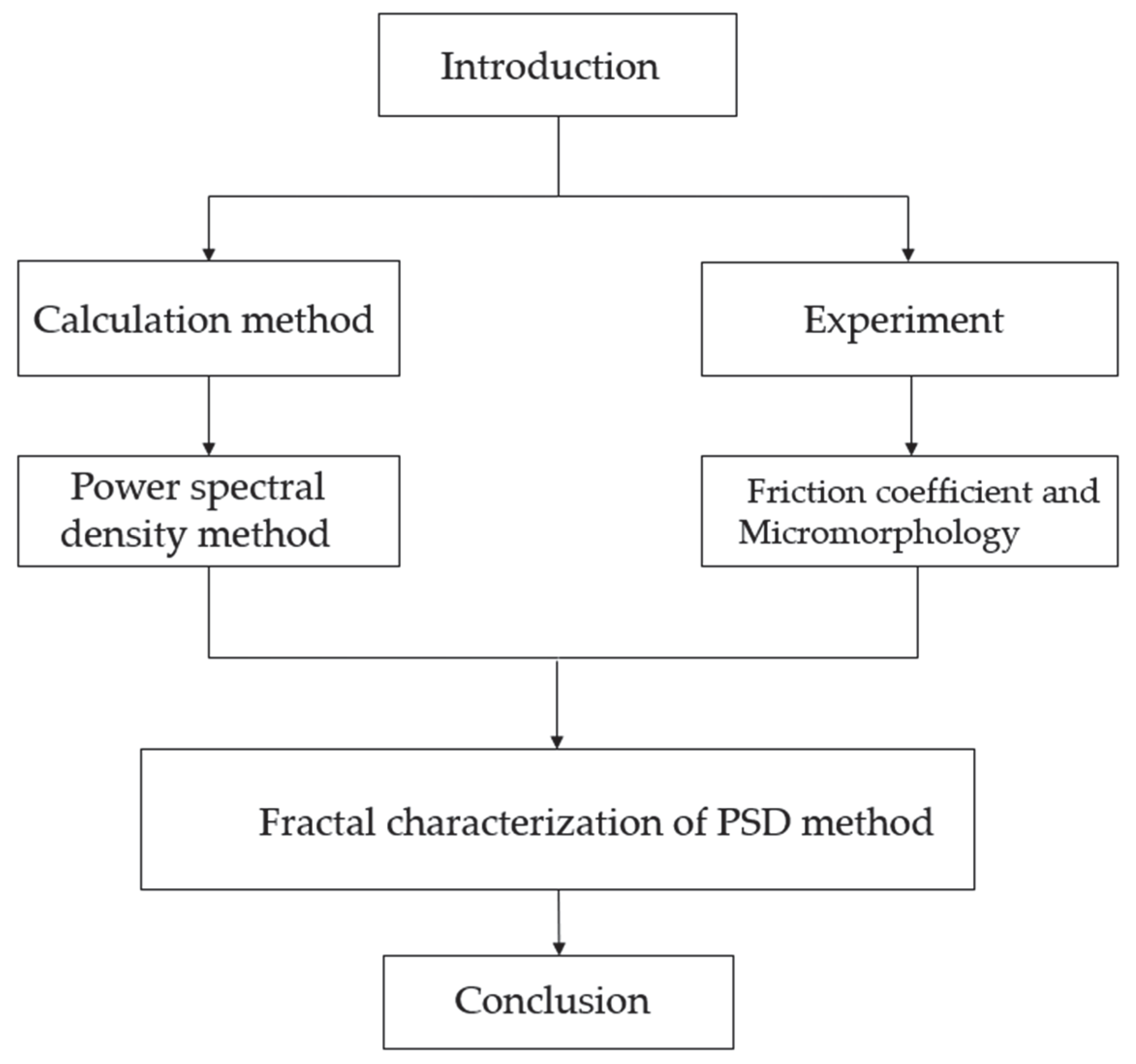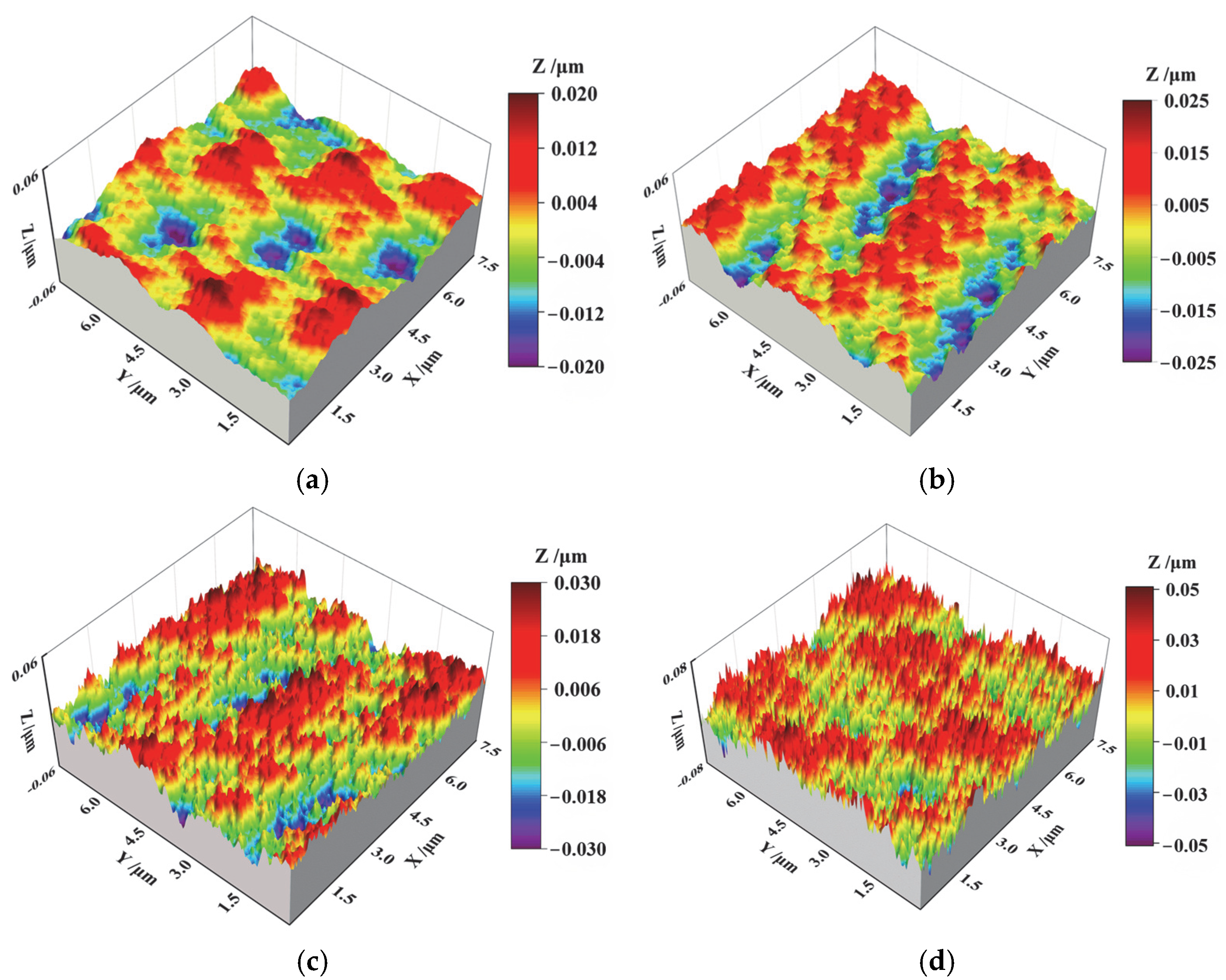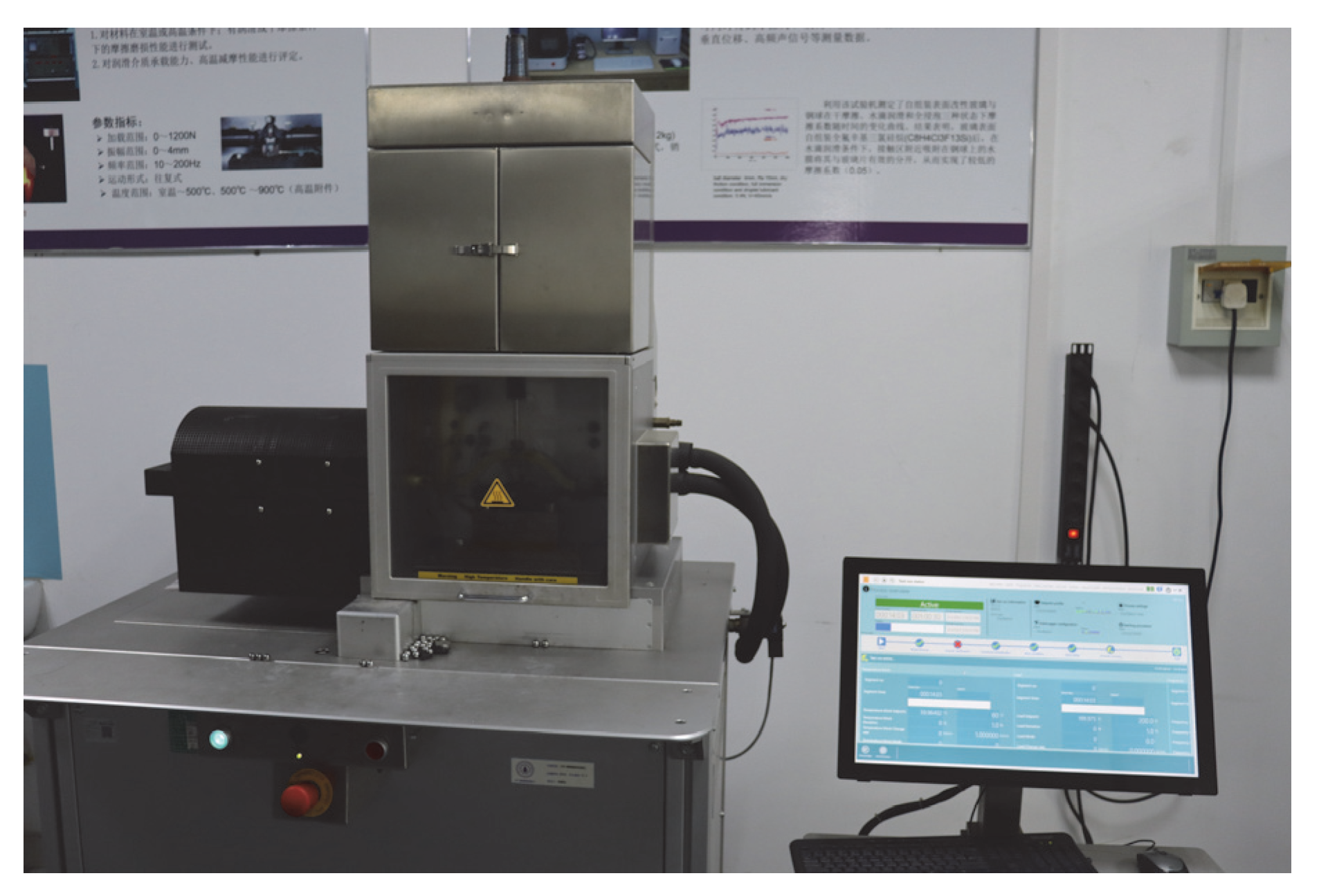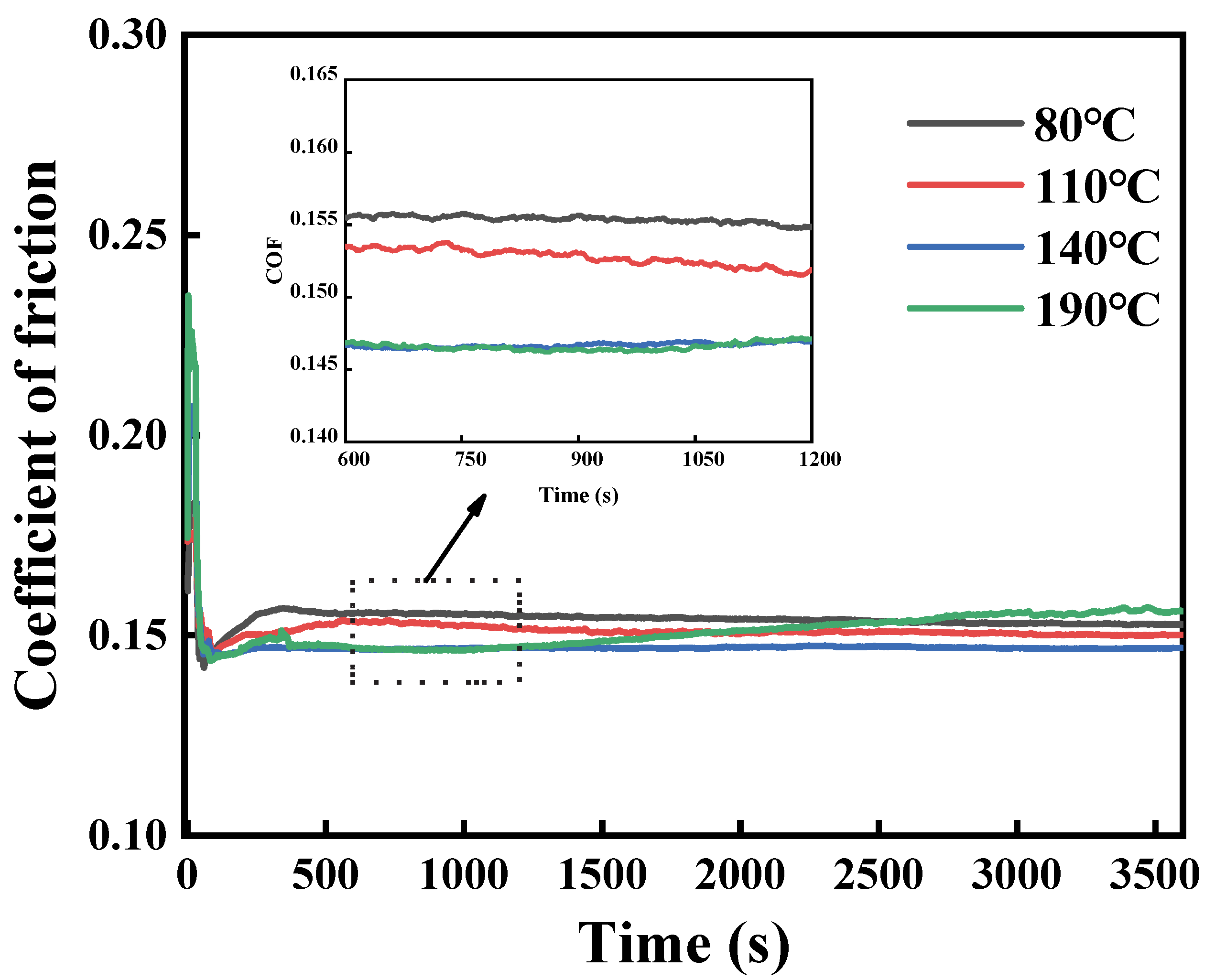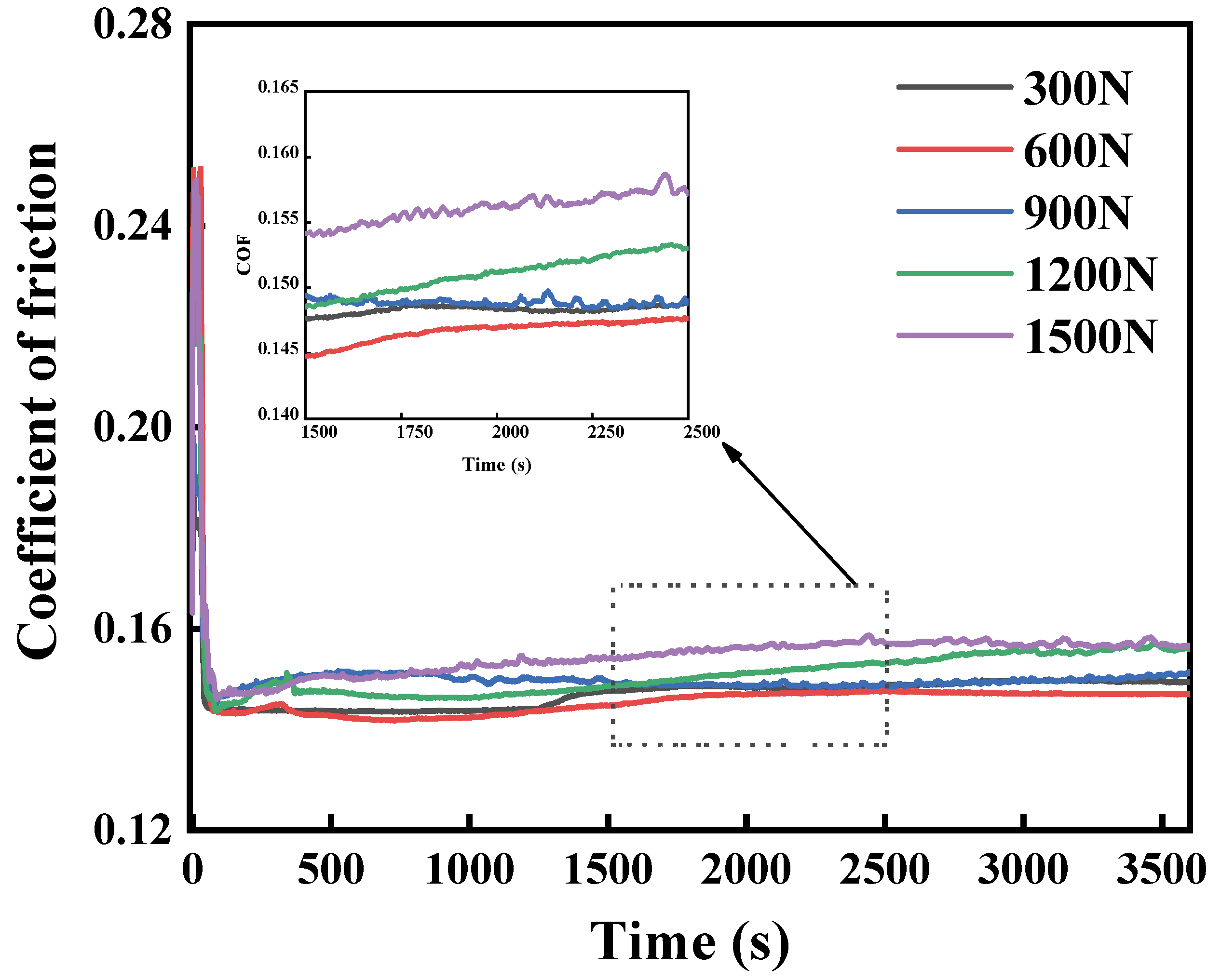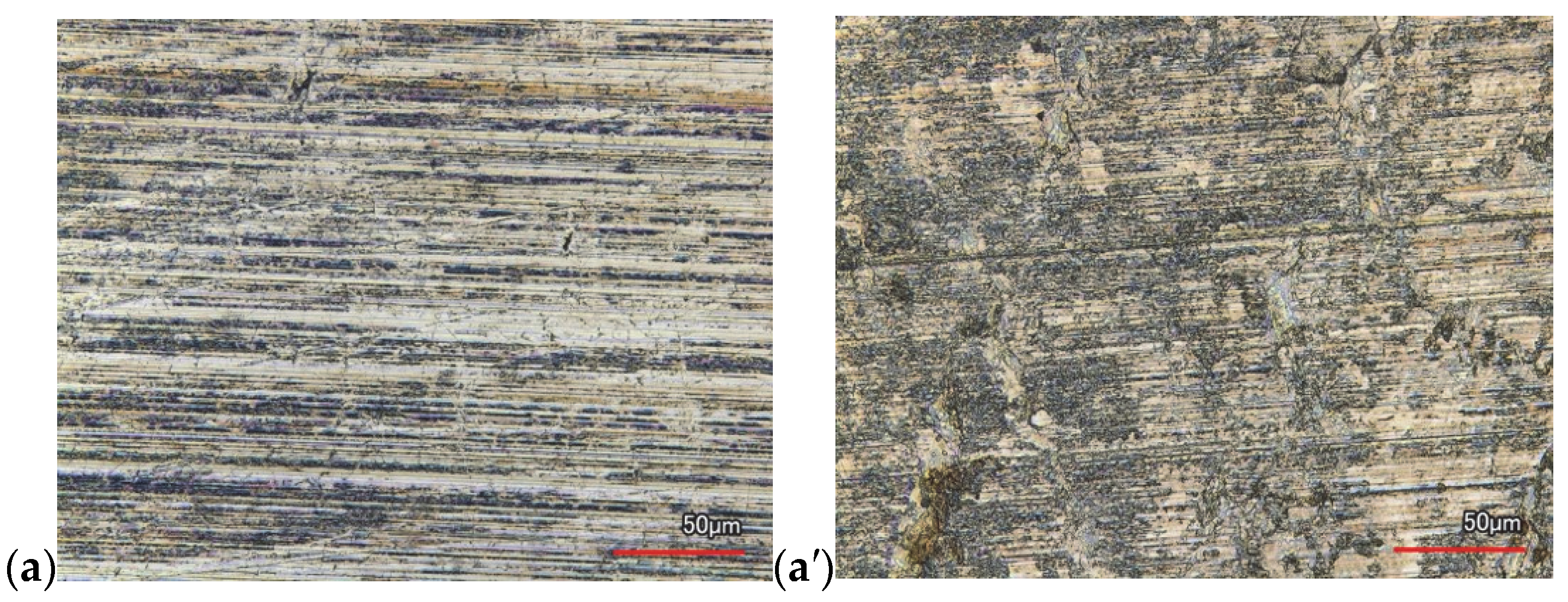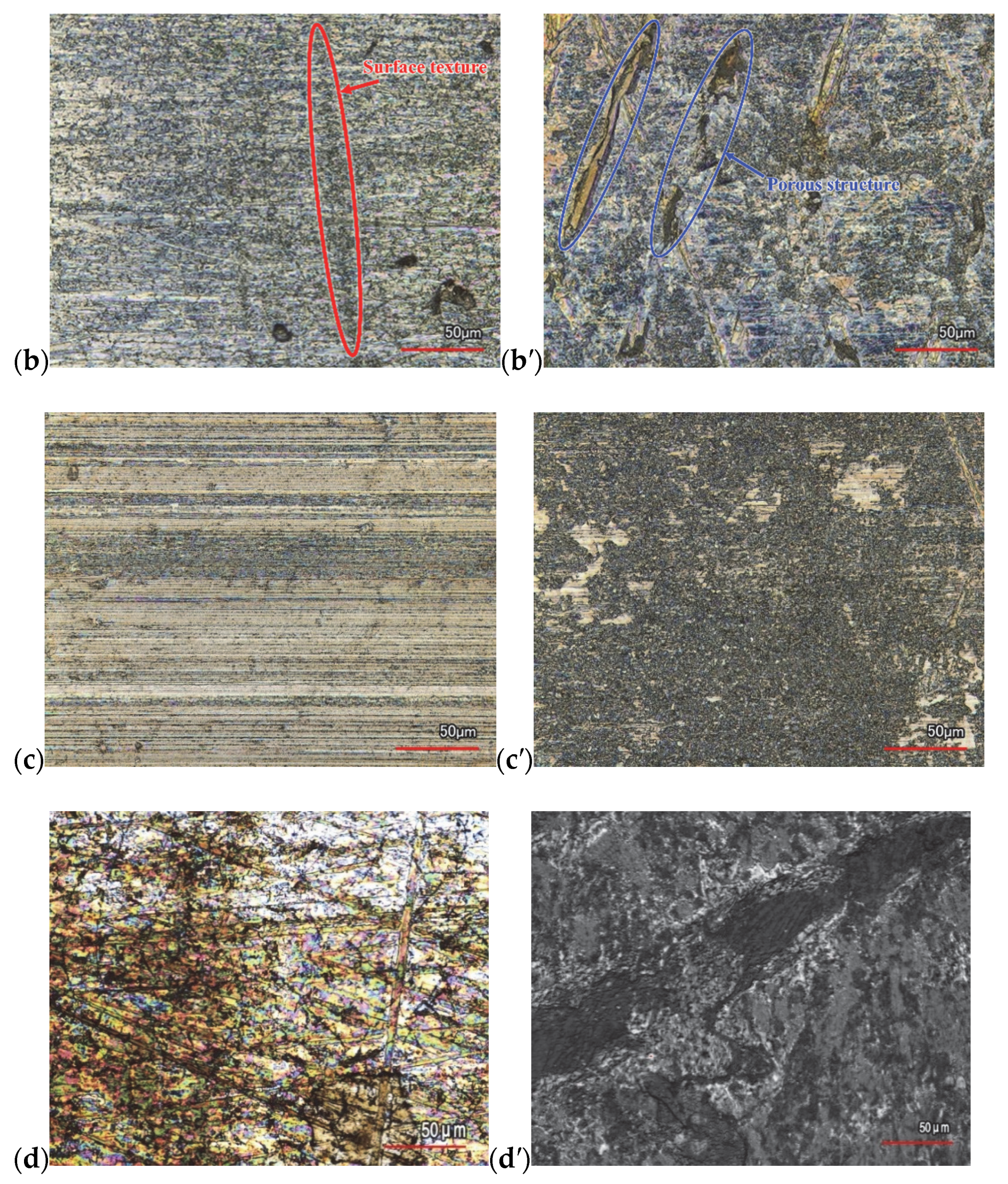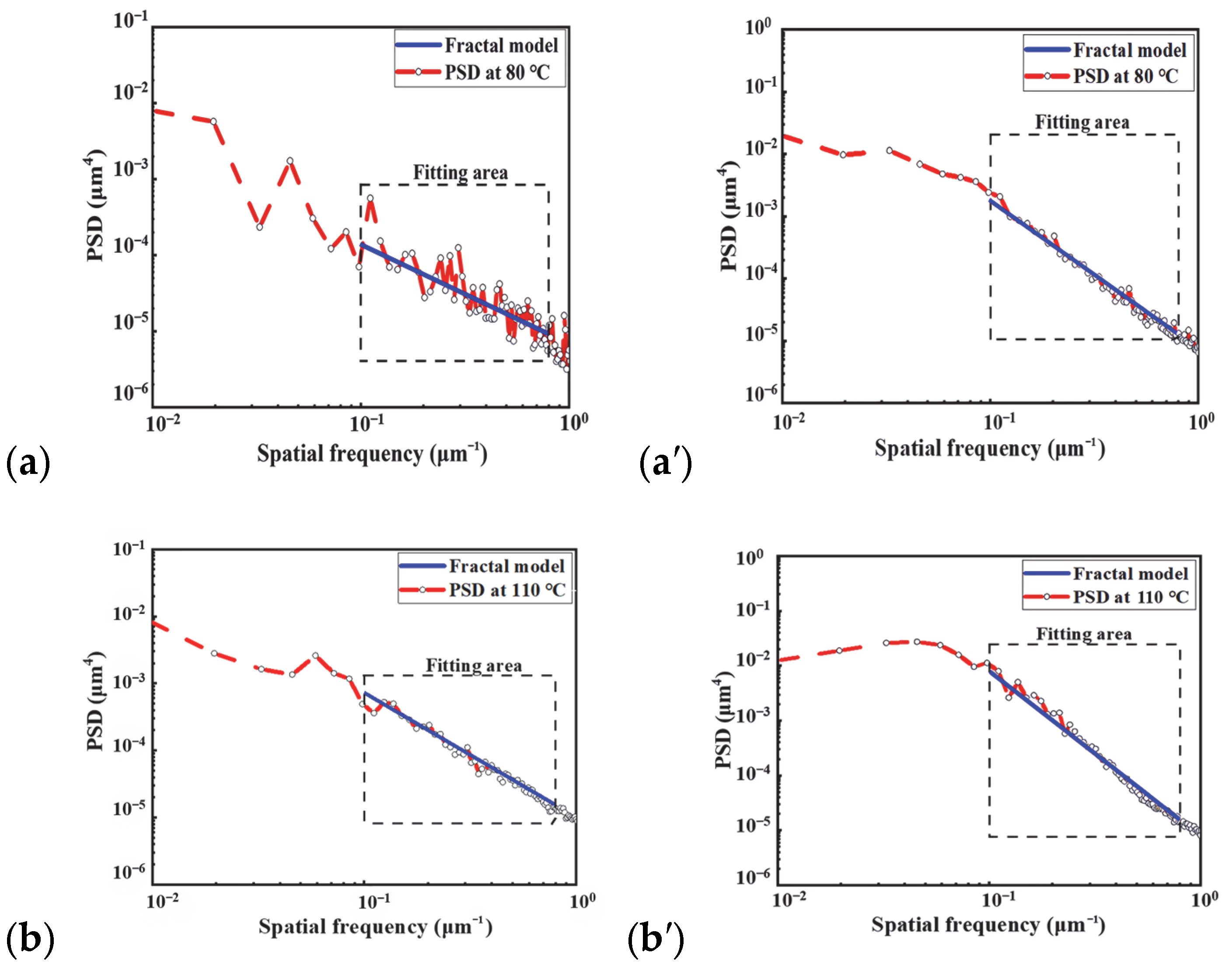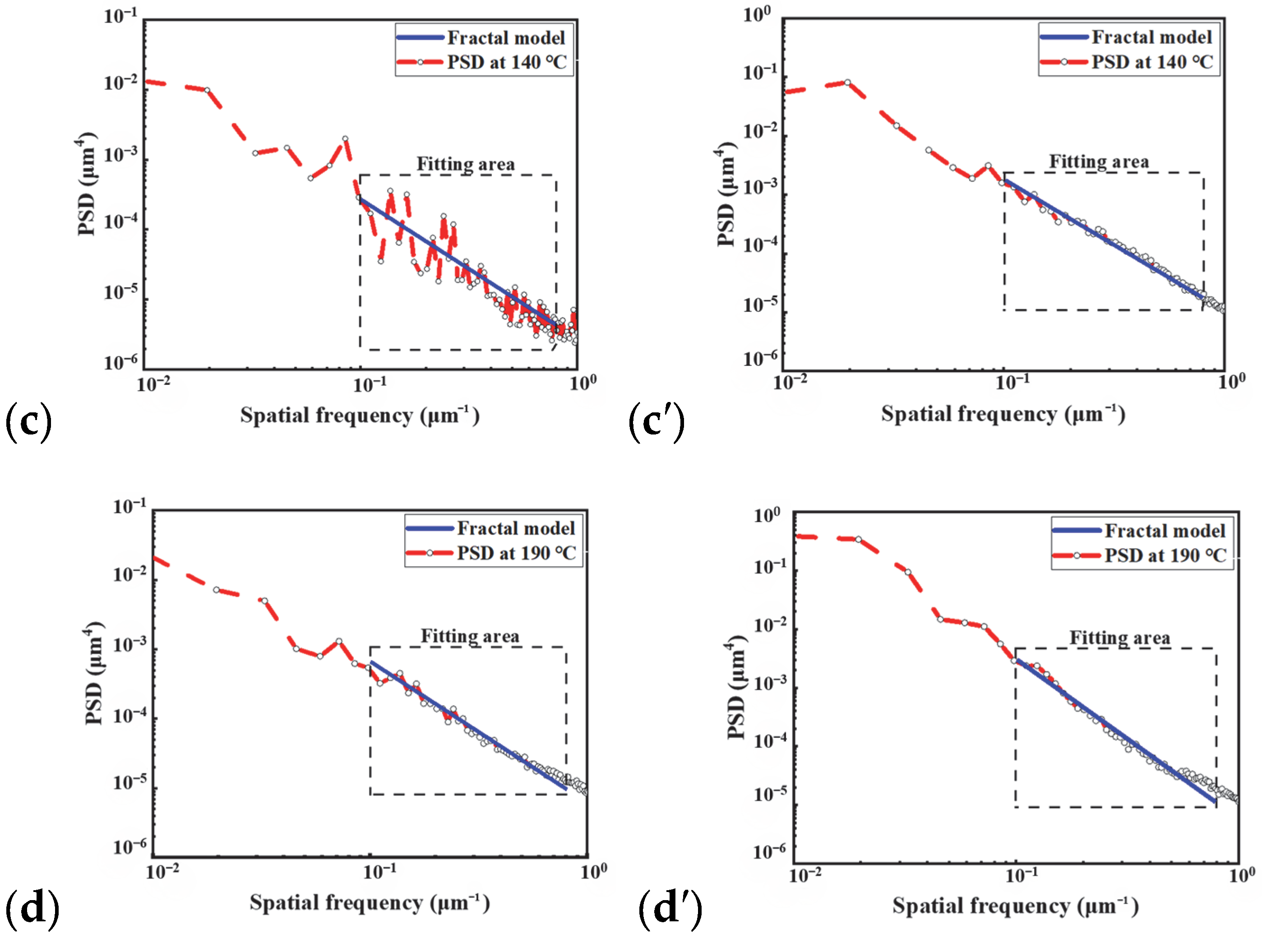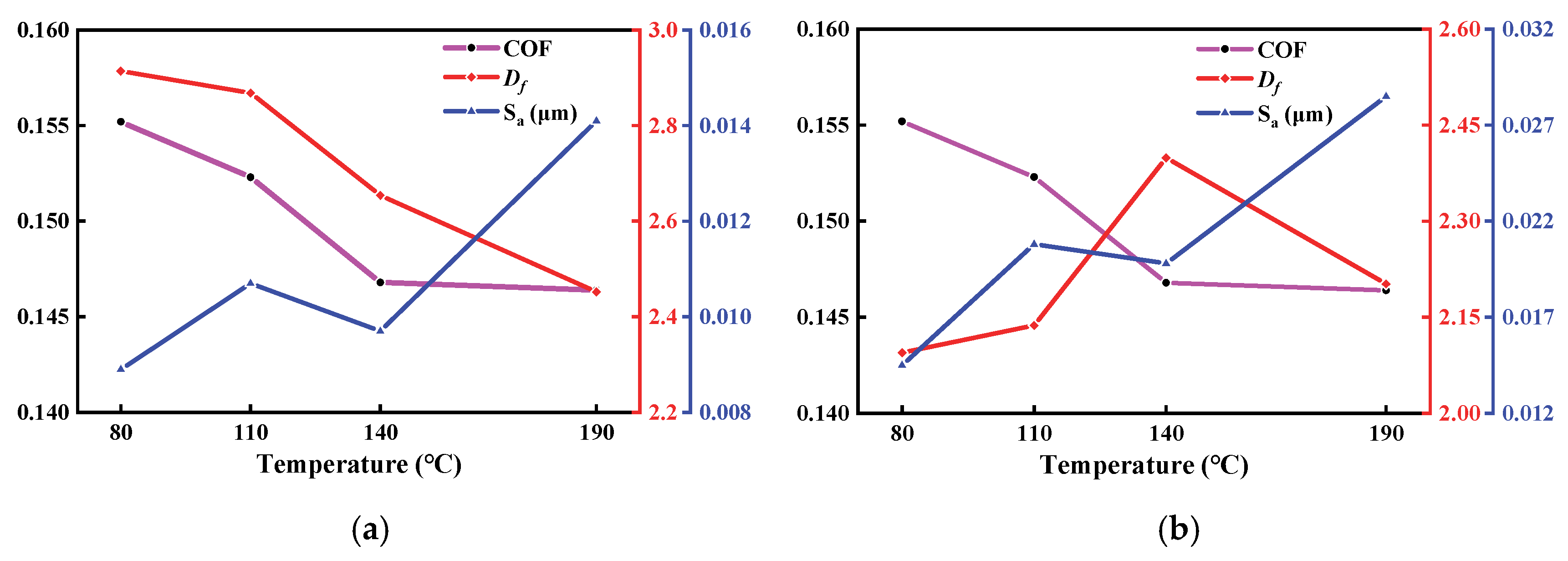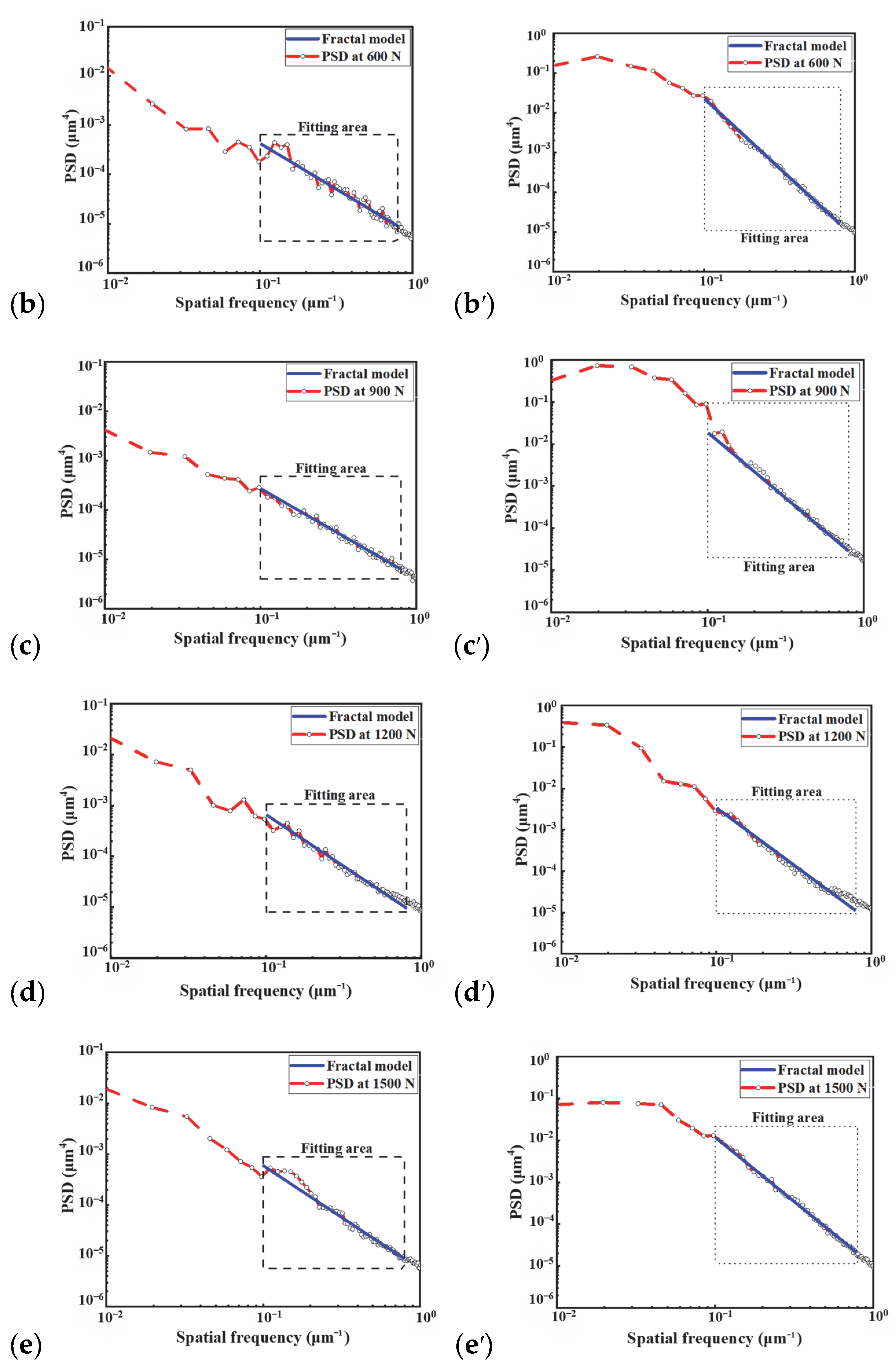1. Introduction
The friction loss of the cylinder liner–piston ring is one of the most significant mechanical losses in an internal combustion engine. According to statistics, about 20–40% of engine friction loss occurs on the cylinder liners and piston rings [
1,
2]. Due to the reciprocating motion of the piston in the cylinder liner, the first piston ring begins the operating phase with quick changes in temperature and pressure at the contact surface, following the high temperature and pressure near the top dead center (TDC) position. The frictional properties of the cylinder liner and piston ring also show complex characteristics with the rapidly changing working conditions [
3,
4].
Temperature has a significant impact on the friction and wear of the piston ring and cylinder liner. The study by Shahmohamadi et al. [
5] showed that in-cylinder combustion leads to high temperatures at the top of the cylinder liner and low temperatures at the bottom, and that the temperature difference of the cylinder liner’s surface at the contact range of the piston ring can reach a temperature span of more than 50 °C. The temperature of the engine cylinder liner has a significant effect on the frictional power consumption of the piston ring, where the difference in frictional power consumption even reaches nearly 50% in the studied temperature range. Meanwhile, the optimal operating temperature exists on the surface of both the cylinder liner and the piston ring to reduce the frictional loss of the piston ring [
6,
7]. It was found that the effect of temperature on friction was mainly reflected in the variation in grease viscosity with temperature during actual friction. Du Chang et al. [
8] conducted experimental studies on the effects of temperature and lubricating oil on the friction performance of cylinder liner–piston ring (CL-PR) systems. Their research revealed that the wear of the friction pair reached its most severe state at 120 °C, with the predominant wear mechanisms being identified as abrasive wear and adhesive wear. Wolff et al. [
9] set the lubricating oil at constant temperatures of 93 °C and 200 °C. The results indicate that, when either the cylinder liner or lubricant temperature is relatively low, the hydrodynamic friction power consumption of piston rings is more significant. At higher temperatures, while the hydrodynamic friction power consumption decreases, the rough contact friction power consumption increases significantly. Zhang Xiang et al. [
10] designed six temperature distribution schemes for cylinder liners, achieving a 34.4% reduction in maximum friction loss compared to the original engine configuration. Valiente-Blanco et al. [
11] studied the coefficient of friction (COF) of polytetrafluoroethylene (PTFE) grease lubricated bushings with Ti6Al4 V alloy shafts at 200 °C. LYU et al. [
12] combined the growth and wear model of the tribofilm caused by zinc dialkyl dithiophosphate (ZDDP) with the temperature field. The results showed that the growth rate of the tribofilm appears to be more dependent on the temperature than on the contact pressure. In addition to the temperature, the external load, speed, and roughness of the friction pair also have an effect on the contact characteristics of the friction pair [
13,
14,
15]. Bewsher’s study [
16] showed that the lubrication state of the engine’s friction pair is dominated by boundary lubrication during the combustion stroke and investigated the effect of combustion products, as well as frictional reaction film, on the frictional characteristics under high-pressure conditions. Zhang et al. [
17] divided the wear states of the cylinder liner and piston ring into mild wear state, medium wear state, and severe wear state, which varied with the operating parameters.
When analyzing the surface wear morphology of piston rings and cylinder liners, geometry-related parameters like roughness, wear depth, wear rate, fractal dimension, and so on are utilized for parameterization. This allows for a more quantitative and in-depth understanding of the wear characteristics, facilitating comparisons between different wear states and providing a basis for further research on tribological properties and the durability of these components [
18,
19,
20]. Zhang et al. [
21] measured the change in wear rate at different speeds and pressures to build the wear map. Liu et al. [
22] optimized the double-sided textured CLPR; a maximum reduction in the friction coefficient of 12.63% was achieved compared to the untextured surface, with corresponding reductions in the wear depth of the cylinder liner and piston ring of 16.73% and 18.25%. Lang et al. [
23] carried out a piston ring–cylinder liner wear test based on different speeds and pressures to obtain a 2D cylinder liner morphology profile and performed a 2D fractal dimension and roughness analysis for the cylinder liner. To sum up, the three-dimensional microfractal characteristics and laws of piston rings and cylinder liners under different operating conditions need to be further investigated. The changes in microscopic morphology can be characterized using the fractal method. The fractal characteristics mean that the similarity exists in the detailed features of the surface morphology at different scales, indicating that the rough surface has self-similarity and scale-invariance [
24,
25,
26]. As a result, the morphological aspects of the rough surface may be described using the fractal function. Pitchumani et al. [
27] employed a two-dimensional fractal model to characterize wettability on randomly rough surfaces. Wujun Feng et al. [
28] further integrated wavelet filters with fractal theory to analyze the surface morphology of titanium alloys, establishing a correlation between fractal dimension and surface roughness. Their research on micro-electrical discharge machining processes revealed that, under constant discharge duration, the fractal dimension increases with decreasing discharge energy. Correspondingly, the elevation in fractal dimension was found to be associated with an increasing trend in surface roughness. Mahmood et al. [
29] combined the roughness parameters and fractal parameters to establish a three-dimensional formula for the fractal surface morphology formed in the cold-rolled workpiece and rolls based on the two-dimensional W-M model. Zhao et al. [
30] used the box-width transformation method to calculate the fractal parameters of the friction bond surface of aluminum and magnesium metals under different welding processes, indicating that the fractal dimension, as an indicator to characterize the surface quality of their joints, is greatly affected by the variation of process parameters. Yi et al. [
31] proposed a fretting damage model based on fractal theory and used the Weierstrass–Mandelbrot function in fractal theory to represent the rough contact surface. Eftekhari et al. [
32] quantified parameters such as the fractal dimension, Hurst index with application of power spectral density data fitting fractal model, and root mean square roughness to investigate the surface morphological characteristics of sputtered yttria-stabilized zirconia (YSZ) films at different annealing temperatures.
Based on the above research findings, there exists a certain correlation between the fractal dimension and surface roughness of friction interfaces. Meanwhile, studies on the three-dimensional microscopic fractal characteristics and evolution patterns of piston rings and cylinder liners under varying operating conditions remain relatively scarce. Currently, there are limited investigations employing power spectral density (PSD) methods to analyze piston rings while simultaneously considering fractal parameter variations under multiple operating conditions involving temperature and pressure changes. To investigate the influence of different operating parameters on surface microtopography in cylinder liner–piston ring friction pairs under various working conditions, this study adopts a sectioned specimen testing approach. High-temperature tribological experiments are conducted under different temperature and pressure conditions to obtain the friction coefficient data and microscopic morphology characteristics of the friction pair. The three-dimensional surface topography is processed using power spectral density analysis, combined with fractal model fitting, to study the evolution patterns of microtopography with the operating parameters.
Figure 1 shows the schematic diagram of the research approach in this paper.
2. Calculation Method and Validation
2.1. Calculation Principle of Fractal Dimension
The fractal dimension is calculated by processing the whole morphology using different measurement scales to obtain the equation of the scaling relationship of the morphological parameters.
The equation for the morphological measure and measurement scale can be expressed as [
33]:
where
Q is the morphological measure, and
δ is the measurement scale. Both c and α are constants.
The fractal dimension of the profile is obtained by constructing a log–log coordinate of Q and δ. Then, a linear fit is made to the dimensional and scaling relationships calculated for the dimension, and a linear equation is established. The fractal dimension of the measured shape is obtained by the slope of the fitted equation.
Three principal methodologies are commonly employed for fractal dimension calculation: the box-counting method, the structure function method, and the power spectral density method. The box-counting method operates by systematically covering a surface with grids of progressively reduced box sizes, quantifying the total number of boxes required for full coverage, and deriving the fractal dimension through statistical regression of the logarithmic relationship between the box count and scale. The structure function method treats two-dimensional profile curves as stochastic time-series data, calculating the fractal dimension by analyzing variance increments across spatial displacements along the horizontal coordinate axis. The PSD method leverages Fourier spectral analysis to decompose surface height variations into spatial frequency components, with the fractal dimension calculated from the power-law scaling of the frequency–amplitude relationship. In this study, a comparative evaluation of the box-counting and PSD methods was conducted under controlled tribological conditions. The analytical results revealed superior robustness and resolution of the PSD method in characterizing multiscale surface degradation patterns. Consequently, the PSD method was selected for a systematic investigation of microtopographical evolution mechanisms in piston ring–cylinder liner systems.
2.2. Box-Counting Method
The box-counting method is one of the most widely used algorithms in fractal dimension calculation methods. Its calculation principle is, for the calculation of the fractal dimension of a two-dimensional graph, assume that there is a box with side length
r. Cover the two-dimensional curve image to be measured with the box, where the box covering the curve to be measured is recorded as a non-empty box, and calculate the number of non-empty boxes, recorded as
S(
r). Then, gradually reduce the scale r and repeatedly calculate the number of non-empty boxes
S(
r) covering the image at the current scale to get the array of (log(
r), log
S(
r)). When r is infinitely close to 0, the box-counting dimension of the curve graph can be calculated. In the calculation, the slope
K of this functional relationship can be obtained using linear regression, counting the box dimension
D = −
K. The fractal dimension
D calculated by the box-counting dimension method can be expressed as follows:
The calculation of the fractal dimension of a three-dimensional surface is generalized from the principle of two-dimensional calculation. When the figure to be measured is a three-dimensional surface
F, assume that there is a cubic box with side length
r, cover the three-dimensional surface with boxes of that scale, and finally, arrive at the number of boxes
S(
r) required to cover the surface. The box-counting dimension of the surface is calculated as in Equation (3) [
34].
2.3. Power Spectral Density Method
The power spectral density method is mainly used for the processing of random time series signals. Extending this to the calculation of fractal dimension, the spatial frequency f of its signal sequence is the scale in the calculation of the fractal dimension. For rough surfaces with the fractal characteristics of contour curves, the fractal dimension is calculated as follows. Calculate the PSD P(f) after processing the discrete data of the contour height of the 2D or 3D shape. The variation in power spectral density P(f) and frequency f of the shape to be measured is plotted as a log-log graph, and it is judged whether the power spectral density P(f) and frequency f satisfy P(f) ∈ f(−β). The exponent β is related to the calculated fractal dimension.
The PSD method can be used to calculate the fractal dimension of three-dimensional surfaces, in addition to the fractal dimension of two-dimensional curves. In the calculation of three-dimensional microscopic morphology, the two-dimensional power spectral density (area power spectral density, APSD) can be used, which is calculated using the Fourier transform autocorrelation function.
The two-dimensional Fourier transform is expanded along the x and y directions of the surface to be measured, so that a three-dimensional surface can be represented in the Cartesian coordinate system by the
z(
x,
y) function, where
z refers to the actual height value at (
x,
y). Since the collected height data are not a continuous signal value, it is necessary to discretize the data when performing the processing. This method of Fourier transforming a finite number of discrete data is the discrete Fourier transform (DFT). The two-dimensional discrete Fourier transform equation is as follows [
32]:
where
fx and
fy denote the frequencies in the
x and
y directions,
fx = 1/
i Tx, fy = 1/
i Ty,
i = 1, 2…
M;
Tx and
Ty are the fixed intervals of sampling points in the
x and
y directions, respectively,
Tx =
Ty; and
M and
N are the number of sampling points in the
x and
y directions.
The 2D PSD can be estimated using a periodogram, and the discrete power spectral density can be approximated by Equation (5):
After PSD calculation,
P and
f are related by a power function:
Then, taking logarithms for both sides of the above equation:
where both
α and
β are fitting parameters.
β and the fractal dimension
D have the following relationship:
2.4. Validation of Methods
After Mandelbrot founded fractal geometry, scholars in related fields proposed the Weierstrass–Mandelbrot fractal function (W-M function) for constructing two-dimensional fractal curves. On this basis, most of the methods for establishing 3D rough surfaces were to obtain fractal contour curves by 2D W-M fractal functions and then extend to the whole rough surface, which has great limitations in accurately characterizing 3D contour surfaces, fractal characterization, and the simulation of rough surfaces. With the development of fractal theory, subsequent scholars have established W-M functions on a three-dimensional scale to simulate the microscopic morphology of the constructed rough surface, which provides an important tool for the study of the contact mechanics of micro-convex bodies and the study of frictional wear properties of material surfaces.
The W-M function can accurately reflect the morphological characteristics of the rough surface constructed with theoretical fractal dimensions and feature scales. Yan and Komvoulos et al. [
35] studied the fractal characteristics of three-dimensional rough surfaces and established a W-M surface for three-dimensional forms, whose three-dimensional expression is given in Equation (9):
where
z(
x,
y) denotes the height value of the profile at (
x,
y).
L is the sampling length.
G is the scale factor.
γ is the characteristic parameter, generally taken as 1.5.
O denotes the number of protruding folds on the constructed surface, and
n is the frequency index.
ϕ(
m,
n) is the random phase, taken as [0, 2π].
Ds is the theoretical fractal dimension, generally taken as 2 <
Ds < 3 for three-dimensional surfaces.
In practical engineering applications, the W-M function is generally used in its discrete form [
36]:
where
Cn is a normally distributed random number obeying a mean of 0 and a variance of 1.
An and
Bn are mutually independent and obey random phases on [0, 2π].
The surfaces constructed by the W-M function have obvious fractal characteristics, so they can be used to verify the accuracy of the box-dimension method and the PSD method to calculate the fractal dimension. The W-M function surface is constructed in Matlab software (2020a version). For the theoretical fractal dimensions set
Ds = 2.2, 2.4, 2.6, and 2.8, respectively, scale coefficients
Cn = 0.001 and
n = 100 were selected, plane coordinates
x = [0.01, 1], and
y = [0.01, 1] were taken, and the step size was 0.01, and the 3D rough surface was drawn as shown in
Figure 2.
It is observed that there is a more obvious trend between the surface morphology and the fractal dimension. As the fractal dimension increases, the number of peaks and valleys increases and becomes more densely distributed, and the morphology tends to be more complex. It can also be seen from the figure that the maximum peak and minimum valley values of the morphology increase with the increase in the fractal dimension at the same feature scale
G. The related results are shown in
Table 1.
The local features of the morphology were more apparent with a low fractal dimension. As the fractal dimension increases, the feature similarity of each region of the morphology increases. That is, the self-similarity of the microscopic morphology increases with the increase in the fractal dimension.
Surfaces with fractal characteristics constructed from the W-M function can be used to verify the computational accuracy of the fractal dimension algorithm.
Table 2 shows the fractal dimensions (
Df) and errors calculated by the box-counting dimension method and the PSD method.
As demonstrated in
Table 2, the box-counting method exhibits higher computational accuracy at lower fractal dimensions, with errors remaining below 1%. However, when the theoretical fractal dimension exceeds 2.6, the calculated values from the box-counting method show minimal variation with the increasing theoretical dimensions. Notably, at a theoretical dimension of 2.8, the computed value remains below 2.6, indicating significant deviation. In contrast, the power spectral density method maintains a stable range of absolute errors across increasing theoretical dimensions, while the relative error decreases proportionally due to the scaling effect of higher theoretical values. Combining the above results and analysis, the PSD method is selected as the main method to calculate the fractal dimension of the 3D morphology.
3. Experiment
In this study, the friction pair of the first piston ring and cylinder liner, which is working under high temperature and pressure conditions, was selected for the determination of the variation of friction and wear behavior with temperature. The selected lubricant is the 15W-40 diesel engine lubricant produced by Mobil Corporation (Irving, TX, USA). The experiment was divided into two parts: the friction experiment and the morphological acquisition. The equipment used for the friction test was the SRV-V high temperature friction and abrasion tester (manufactured by Optimol Instruments Prüftechnik GmbH, Munich, Germany), and the other equipment used to collect morphological data was the VK-150K 3D laser microscopic imager (manufactured by Keyence Corporation, Osaka, Japan). The equipment is shown in
Figure 3.
The SRV consists of a temperature control module, a mechanical module, software, and a test stand. During the friction process, the ambient temperature, friction load, and running speed may be regulated, and a variation curve of the friction coefficient with a time series can be obtained.
The experiments used the cut section of the cylinder liner and piston ring to simulate the friction behavior in real working conditions. The experimental materials were selected from the cylinder liner and piston ring components originally produced by the same model of diesel engine. Due to space constraints on the experimental bench, it was not possible to use complete cylinder liners and piston rings for the experiment. Therefore, according to the requirements of the experimental equipment, the cylinder liners and piston rings were cut, and experiments were conducted using cut samples. The cut samples of the piston rings and cylinder liners were selected with a straight-line spacing of 20 mm at both ends to ensure proper friction surface fit during assembly. When designing the constant temperature experiment, seven experimental temperature points were set between 80 °C and 300 °C. After the experiment, the coking status of each group of experiments was examined. The experimental samples at 80 °C, 110 °C, and 140 °C showed no obvious coking. The samples at 190 °C exhibited some coke deposits, while the samples at 230 °C, 270 °C, and 300 °C all had a significant amount of black coke deposits, which were difficult to remove during subsequent cleaning. At the same time, the friction coefficient fluctuated significantly at 230 °C, 270 °C, and 300 °C, and the transmission device and fixtures of the experimental bench exhibited noticeable vibrations. When designing the constant pressure experiment, the maximum contact load of the cylinder liner–piston ring friction pair near the top dead center of the diesel engine under study was 16.82 MPa, and the minimum load near the bottom dead center was 0.27 MPa. The loading range was calculated to be [20, 1200] N based on the actual area of the friction contact surface of the sample. Based on the above experimental phenomena, four constant temperature conditions ranging from 80 °C to 190 °C were selected for the constant temperature experiment. In the constant pressure experiment, loads of 300 N, 600 N, 900 N, 1200 N, and 1500 N were selected for the experiment. In constant temperature conditions, the friction test parameters were specified as 60 min sliding time and 0.14 m/s sliding speed for temperatures of 80 °C, 110 °C, 140 °C, and 190 °C. Under constant pressure conditions, tests were carried out at 300 N, 600 N, 900 N, 1200 N, and 1500 N while the sliding time and speed were the same as the fixed temperature condition.
Table 3 shows the controlled parameters for the constant temperature and pressure experiments.
After the friction experiments under different working conditions, the microscopic morphology of the cylinder liner and piston ring was collected by the 3D laser microscopic imager. The microscope imager is set to 2.66235 × 10−4 (μm/pixel) for planar accuracy and 1 × 10−4 (μm/pixel) for vertical accuracy.
4. Experimental Results and Discussion
4.1. Variation of Friction Coefficient
In the experimental groups with constant temperature or pressure, the variation curves of the friction coefficient for the experimental groups with constant temperature or pressure are shown in
Figure 4.
In the constant temperature experiments, the friction coefficients at all operating conditions showed large irregular changes within about 50 s after the start of the friction process. In the friction experiments at 190 °C, the high temperature resulted in local heat accumulation at the rough peak position, and some coking material was also present on the surface of the specimen after the experiment. After 1500 s of friction processes, the friction coefficient is already at the end of the stable stage. With the further increase in the friction time, the coking material accumulated, making the friction coefficient also show a slow increase. In the three sets of experiments at temperatures below 190 °C, the friction coefficient has always shown a stable state, and there is no obvious coking phenomenon during the friction process because the experimental temperature is far below the deterioration temperature of the lubricant.
At the late friction stage, the friction coefficient at low-temperature operating conditions also shows a slightly decreasing trend after reaching the stable stage, mainly due to the presence of a small amount of friction-reducing additives in the lubricant. During these friction processes, the plastic stress and shear force increase, and a large amount of frictional heat is generated as the contact surface of the friction sub increases. The friction reaction film is gradually formed under the action of plastic stress and frictional heat, thus acting as a friction reduction.
Based on the above experimental phenomena, the average value of the coefficient of friction, calculated from the data within 600 s to 1200 s at the beginning of the experiment, was chosen as the typical data for characterizing the coefficient of friction at the corresponding temperature. The COFs in this region are shown in
Table 4.
As shown in
Table 4, the coefficient of friction at 80 °C is the largest in the constant temperature experiments at these four temperature points. When the temperature increases, the coefficient of friction decreases instead, while the coefficients of friction at 140 °C and 190 °C are similar.
The variation curves of the friction coefficient for each working condition in the constant pressure experiment are shown in
Figure 5.
Table 5 shows the peak and valley values of the COF variation in this region.
As shown in
Figure 5 and
Table 5, the friction coefficient decreases with the increasing load at lower loads. This phenomenon is mainly related to the following two reasons:
- (1)
(At 190 °C, the low viscosity of lubricating oil leads to the existence of micro-convex contact in the friction state. However, the number of rough peak contacts is low, and the actual contact area of the friction surface is small at lower loads. According to the mechanism of pressure on friction, the actual frictional contact area S is proportional to the two-thirds power of the pressure between the friction pairs, so the proportion of the increase in contact area is much smaller than the proportion of the increase in load, which means the proportion of the increase in the force of friction is also smaller than the proportion of the increase in pressure;
- (2)
When the load increases, the contact area of the rough peak increases, and the additives in the lubricating oil contact with the metal surface and form a friction reaction film, thus producing a certain antifriction effect.
With the further increase in load, when the load reaches 900 N or more, the effect of the friction-reducing substances in the lubricant on the friction coefficient is smaller than the increase in friction force with the increase in load, thus making the trend of friction coefficient change from decreasing to increasing after the friction pair enters the higher load condition.
4.2. Micromorphology Under Different Working Conditions
Figure 6 shows the micromorphology of cylinder liners and piston rings after friction at 80 °C, 110 °C, 140 °C, and 190 °C. From
Figure 6, the microscopic morphology of the cylinder liners after friction was dominated by friction marks. In the microstructure of the piston rings, the original microcrack structure was enlarged to form a dotted or reticulated porous structure on the outer surface of the piston rings after the special process of chromium plating technology. The
of the microstructure of the cylinder liner and piston ring in the constant temperature tests are shown in
Table 6. The surface roughness of the cylinder liner was significantly higher in the high temperature condition than in the low temperature condition, while the surface roughness of the piston ring did not show a clear pattern with the friction temperature.
Figure 7 shows the micromorphology of cylinder liners and piston rings under different pressure conditions, and the microscopic morphology under 1200 N is shown in
Figure 6d,d′ for 190 °C. The
of the microstructure of the cylinder liner and piston ring in the constant pressure tests are shown in
Table 7.
From
Figure 7a–d, there are several obvious parallel distributions of “gully” shape in the micromorphology of the cylinder liner at 300 N. These features are the original surface texture of the cylinder liner surface. Due to less wear at the corresponding pressure of 300 N, the textural features of the surface weave were retained more on the microscopic surface of the friction contact surface. As the load increases, the parallel distribution of the “gully” shape is gradually replaced by dense friction marks.
The distribution of the overall contour of the piston ring was highly variable in
Figure 7a′–d′, primarily due to the prominence of the “reticulate” porous organization of the surface, although there is a clear distribution of friction marks on the low-gradient surface regions. But, the overall wear level is not enough to make the friction marks cover the original microcrack structure.
6. Conclusions
This study attempts to present the effect of friction temperature and pressure on the microscopic morphology of a cylinder liner and piston ring by fitting a fractal model using the PSD method. The friction coefficients and micromorphology of cylinder liners and piston rings under various conditions were obtained by simulating different temperature and pressure working conditions of internal combustion engines with the SRV friction test machine. The data from the PSD method obtained after processing the micromorphology was fitted into the fractal model to obtain the fractal and roughness parameters. The processing results of the fixed temperature experiment show that, within 80–140 °C, the increase in temperature and decrease in lubricant viscosity make the rough peak contact increase and the micro-morphology become more complex. When the temperature rises to 190 °C, due to the phenomenon of lubricant degradation and coking of the friction contact surface, the friction conditions are more severe. As the distribution of friction marks on its surface is more complex, the fractal dimension is reduced while its surface roughness also increases. In the lower-pressure conditions, the surface morphology of the cylinder liner is dominated by the original surface weave. Due to the interlaced friction patterns and surface textures, the fractal dimension grew and the roughness reduced as the pressure increased. When the pressure reached 1200 N or more, the surface roughness tended to increase and the fractal dimension decreased. The surface roughness tended to rise and the fractal dimension fell.
The relevant parameters of the piston ring also showed a similar regular variation to the cylinder liner. The calculation of fractal dimension and roughness was also affected when the surface of the microform had a machining structure with a large gap between the scale and friction marks.
In this study, fractal theory is primarily applied to characterize the surface morphology of friction pairs at microscopic scales. Building upon this foundation, we can further integrate fractal theory with the established morphological evolution patterns under varying temperature and pressure distributions to develop a fractal contact model. This model will facilitate friction simulation calculations to investigate the influence of the relevant fractal parameters on contact stiffness and damping characteristics.
